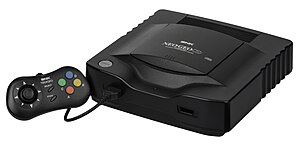Neo Geo CD

The Neo Geo CD system
|
|
| Manufacturer | SNK Corporation |
|---|---|
| Type | Home video game console |
| Generation | Fourth generation |
| Release date | |
| Discontinued | 1997 |
| Media | CD-ROM |
| CPU | Motorola 68000 running at 12 MHz |
| Predecessor | Neo Geo AES |
Neo Geo CD (Japanese: ネオジオCD Hepburn: Neo Jio Shī Dī?) is the second home video game console of SNK Corporation's Neo Geo family, released in September 9, 1994, four years after its cartridge-based equivalent. This is the same platform, converted to the cheaper CD format retailing at $49 to $79 per title, compared to the $300 cartridges. The system was originally priced at US$399, or £399 in the UK. The unit's 1X CD-ROM drive is slow, with very long loading times of up to 56 Mbit of data per load. The system can also play Audio CDs. All three versions of the system have no region-lock. The Neo Geo CD was launched bundled with a control pad instead of a joystick like the AES version. However, the original AES joystick can be used with all three Neo Geo CD models.
As of March 1997, the Neo Geo CD had sold 570,000 units worldwide.
The Neo Geo CD was first unveiled at the 1994 Tokyo Toy Show. The console uses the same CPU set-up as the arcade and cartridge-based Neo Geo systems, facilitating conversions, and SNK stated that they planned to release Neo Geo CD versions of every Neo Geo game still in the arcades.
Three versions of the Neo Geo CD were released:
The front-loading version was the original console design, with the top-loading version developed shortly before the Neo Geo CD launch as a scaled-down, cheaper alternative model. The CDZ was released on December 29, 1995 as the Japanese market replacement for SNK's previous efforts (the "front loader" and the "top loader"). The Neo Geo CD had met with limited success due to it being plagued with slow loading times that could vary from 30 to 60 seconds between loads, depending on the game. Although SNK's American home entertainment division quickly acknowledged that the system simply was unable to compete with the 3D-able powerhouse systems of the day like Sega's Saturn and Sony's PlayStation, SNK corporate of Japan felt they could continue to maintain profitable sales in the Japanese home market by shortening the previous system's load-times.
...
Wikipedia
